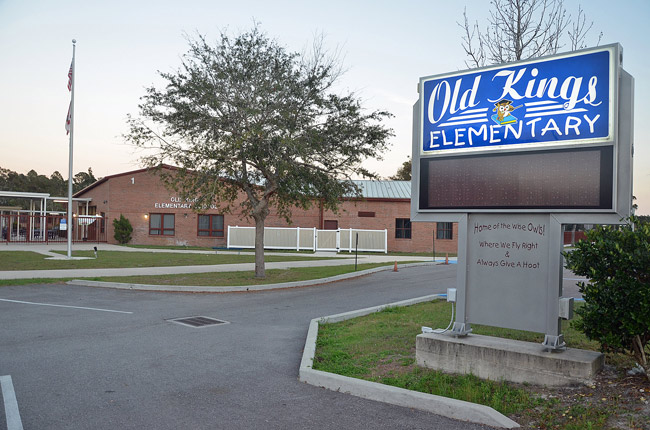
Renee Beckham has six children ranging in age from 7 to 23. She’s known her share of schools, of school rules, restrictions and quirks. On Wednesday she learned a new one.
Beckham has a second grader at Old Kings Elementary. He has scoliosis, a curving of the spine. It’s severe enough that he has to wear a brace for 16 hours a day. Recently her son was fitted with a new brace, but it’s had issues. Beckham on Wednesday morning wanted to see her son’s teacher to show her where and how to mark the brace when it hurts her child, so they can make adjustments. They had just returned from the clinic. She had a note. To Beckham, it seemed like a reasonable request for a quick drop-in in the classroom.
But it doesn’t work that way. The school receptionist did not let Beckham go through. Beckham isn’t faulting the receptionist. She asked to talk to the principal. The principal couldn’t be located. Beckham waited 15 minutes and finally told the receptionist: “Thank you have a great day I’m going to talk to the school board on this issue.”
When she spoke to student services at the district office, Beckham was told she would have had to be finger-=printed and background checked by a staffer—an obvious error for which the district’s Denise Haymes, a senior administrator, quickly apologized to Beckham, explaining that it had been a misunderstanding about Beckham’s intentions. That still didn’t get Beckham to see her child’s teacher.
“It’s OK for a parent to disturb a class for cup cakes but it’s not OK for a parent to go back to talk to a teacher about a medical need for a child?” Beckham asked.
The answer is a qualified yes, depending on the circumstances. Beckham’s case is not unusual in that it reflects a misunderstanding among some parents regarding the line between classrooms’ open door policies to parents (who have every right to observe their child’s classroom in action, or see their child’s teacher) and how that policy is qualified by certain requirements and case-by-case issues.
District officials—Kristy Gavin, the district’s attorney, and Robin Dupont, the principal at Old Kings Elementary—say Beckham would not have been denied seeing her child’s teacher had some arrangement been made ahead of time, or had Dupont had a chance to speak with Beckham.

Beckham said she had to get to work and could not linger at the school, insisting that the matter was both urgent, being a medical issue, and of very brief duration. “That school has taken every right of me as a parent to go visit that classroom at any given day any given time,” Beckham said.
That’s overstating the case, Gavin says. It is in fact not true that parents have the right to walk into their child’s classroom any given day at any given time. But Gavin concedes that while some schools do a better job than others to explain what the parameters of classroom visits are, the district as a whole has not done a good enough job to feature the explanation prominently on each school’s website, “and that’s something I’m going to have Jacob address with the principals,” Gavin said, referring to Jacob Oliva, the superintendent.
Gavin said every parent has the right to visit a classroom with 24 hours’ notice, as well as set up appointments with teachers with some advance notice. “A medical emergency situation, absolutely, we’re not going to go up and say sorry, 24 hour notice, but in this case it’s to ensure we don’t have a disruption of the classroom.”
What’s an emergency to one parent may not be an emergency to a school official. The call is left up to school officials. But Beckham did not give it enough time for such a call to be made, Gavin says. “If she would have waited longer,” Gavin said, “I’m certain that what would have happened is the principal could have checked the schedule to see whether the teacher had a time when she could meet, so she could bring in the teacher to speak to the parent. That requires the principal to say, or an administrator, to say, OK, I’m going to need to have this teacher alleviated of her responsibilities, I’m going to have someone else go in there.”
To parents familiar with the perennial bringing of cupcakes, which does interrupt instructional time, the rules can seem arbitrary and absurd. But even then, Gavin says, there’s a method to the cupcakes. “Usually again those are in advance, they will notify—my child’s birthday is tomorrow, I plan on bringing blah blah blah blah,” Gavin said.
What created a grayer area was the clearly legitimate medical issue and a working parent’s own time crunch. “It’s one of those catch 22’s I get that she was on a deadline,” Gavin said, “but unfortunately we didn’t have an administrator right there at her beck to meet her need and that’s very unfortunate.”
In the end Beckham says she got to speak with her son’s teacher later that afternoon and gave her the directions she’d intended. “She’s wonderful, she’s nothing to blame in none of this, she is awesome, and she did try her best to do what I needed done,” Beckham said, but the teacher nevertheless did not carry out the instructions as Beckham would have provided them had she been able to show her in person that day.
In emergency situations, it comes down to this, in Dupont’s words: “We want our children and our parents to be able to have their needs met but we also have to protect pour children’s learning time as well.”





























Leave a Reply